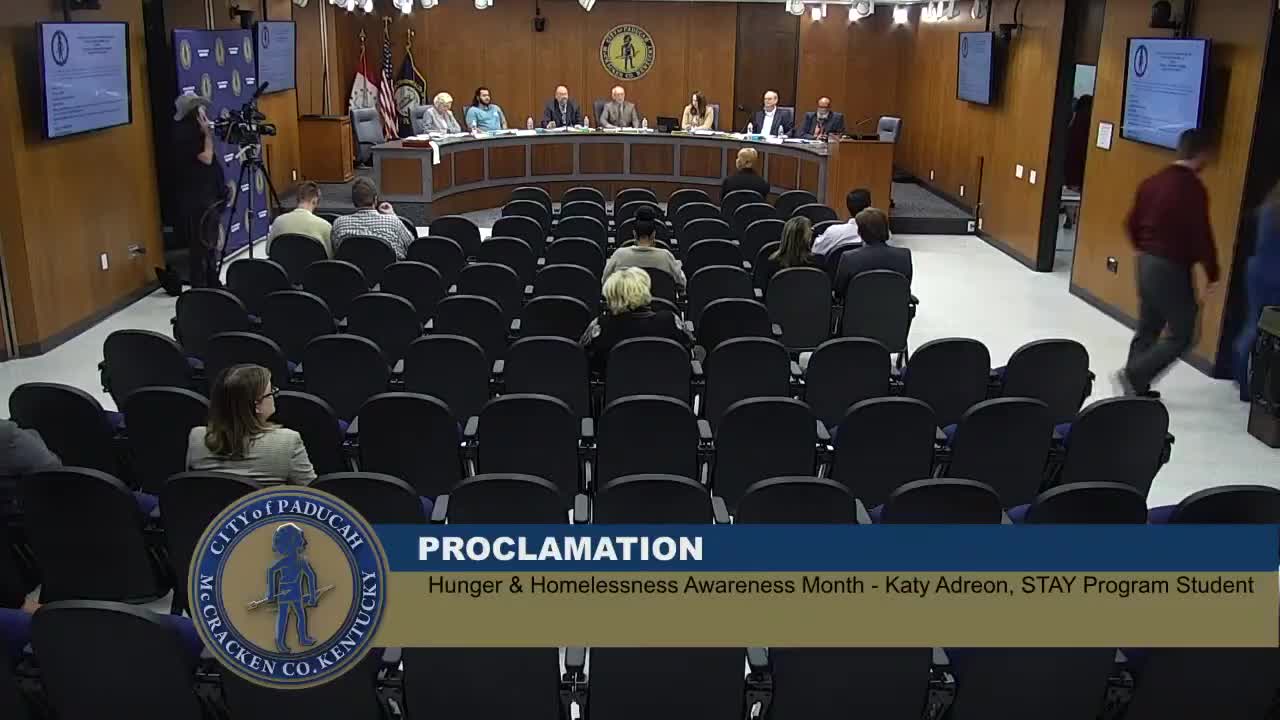Paducah Transit unveils fixed‑route redesign, launches MyRide real‑time app
November 05, 2025 | Paducah City, McCracken County, Kentucky
This article was created by AI summarizing key points discussed. AI makes mistakes, so for full details and context, please refer to the video of the full meeting. Please report any errors so we can fix them. Report an error »

Jeremy Bumpus, executive director of the Paducah Transit Authority, told the Paducah City Commission on Nov. 4 that the authority has redesigned its fixed‑route network and launched a real‑time rider app.
Bumpus said the fixed system now runs four color‑coded routes (red, blue, green and yellow) with approximately 130 designated stops across the city. He described the change from a decades‑old “hail” system to designated stops as a safety and efficiency improvement and said the system recorded about 192,000 trips last fiscal year across fixed‑route and demand‑response services — roughly 146,000 fixed‑route trips and about 46,000 demand‑response trips. Demand‑response rides, he said, include longer medical trips outside the city to Lexington and Nashville, often for Medicaid patients.
The system operates roughly 7 a.m. to 7 p.m. six days a week, with the final fixed‑route run shortly before 6:30 p.m. and a scheduled door‑to‑door service for riders who call 24 hours in advance. Bumpus said the transit authority introduced a real‑time tracking tool — an online interface at pats.mytransit.live and a mobile app called MyRide — that shows vehicle position, estimated arrival and capacity and should improve planning and rider experience. The app was released Oct. 16; staff said download metrics have not yet been compiled but can be obtained from the app developer.
Commissioners asked about extending service hours, including later runs to serve mall employees and nighttime flights. Bumpus said transit staff studied extended hours but found ridership after 7 p.m. historically insufficient to support the cost of drivers and operations, though he did not rule out future hour extensions if demand increases. He noted some private options such as rideshare exist but are spotty in the market.
Bumpus also told the commission that Paducah has become an urbanized area and that the transit authority is unique in Kentucky for serving both an urbanized area and surrounding rural counties; as a result, he said, PATS receives federal funding directly from the Federal Transit Administration and from the Kentucky Transportation Cabinet.
The presentation closed with staff offering to supply download and ridership trend data; commissioners encouraged the authority to share several months of app‑usage figures so the city can help promote the new tool.
The commission did not take action on the presentation; staff said they will return data to the commission when available.
Bumpus said the fixed system now runs four color‑coded routes (red, blue, green and yellow) with approximately 130 designated stops across the city. He described the change from a decades‑old “hail” system to designated stops as a safety and efficiency improvement and said the system recorded about 192,000 trips last fiscal year across fixed‑route and demand‑response services — roughly 146,000 fixed‑route trips and about 46,000 demand‑response trips. Demand‑response rides, he said, include longer medical trips outside the city to Lexington and Nashville, often for Medicaid patients.
The system operates roughly 7 a.m. to 7 p.m. six days a week, with the final fixed‑route run shortly before 6:30 p.m. and a scheduled door‑to‑door service for riders who call 24 hours in advance. Bumpus said the transit authority introduced a real‑time tracking tool — an online interface at pats.mytransit.live and a mobile app called MyRide — that shows vehicle position, estimated arrival and capacity and should improve planning and rider experience. The app was released Oct. 16; staff said download metrics have not yet been compiled but can be obtained from the app developer.
Commissioners asked about extending service hours, including later runs to serve mall employees and nighttime flights. Bumpus said transit staff studied extended hours but found ridership after 7 p.m. historically insufficient to support the cost of drivers and operations, though he did not rule out future hour extensions if demand increases. He noted some private options such as rideshare exist but are spotty in the market.
Bumpus also told the commission that Paducah has become an urbanized area and that the transit authority is unique in Kentucky for serving both an urbanized area and surrounding rural counties; as a result, he said, PATS receives federal funding directly from the Federal Transit Administration and from the Kentucky Transportation Cabinet.
The presentation closed with staff offering to supply download and ridership trend data; commissioners encouraged the authority to share several months of app‑usage figures so the city can help promote the new tool.
The commission did not take action on the presentation; staff said they will return data to the commission when available.
View full meeting
This article is based on a recent meeting—watch the full video and explore the complete transcript for deeper insights into the discussion.
View full meeting
